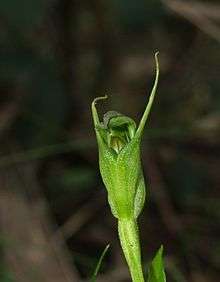Pterostylis foliata
Pterostylis foliata, commonly known as the slender greenhood, is a species of orchid widespread in south-eastern Australia and New Zealand. Flowering plants have a rosette of three to six, dark green, crinkled leaves crowded around the flowering stem and a single dark green and brown flower with a deep V-shaped sinus between the lateral sepals.
| Slender greenhood | |
|---|---|
 | |
| Pterostylis foliata growing near Anglesea | |
| Scientific classification | |
| Kingdom: | Plantae |
| Clade: | Tracheophytes |
| Clade: | Angiosperms |
| Clade: | Monocots |
| Order: | Asparagales |
| Family: | Orchidaceae |
| Subfamily: | Orchidoideae |
| Tribe: | Cranichideae |
| Genus: | Pterostylis |
| Species: | P. foliata |
| Binomial name | |
| Pterostylis foliata | |
Description
Pterostylis foliata is a terrestrial, perennial, deciduous, herb with an underground tuber. Flowering plants have a rosette of between three and six dark green, crinkled leaves crowded around the base of the flowering stem, each leaf 30–80 mm long and 10–16 mm wide. A single flower 17–20 mm long and 7–9 mm wide is borne on a spike 120–300 mm high. The flowers are dark green and brown. The dorsal sepal and petals are fused, forming a hood or "galea" over the column but the dorsal sepal is longer than the petals and has a sharp point on its end. The lateral sepals are erect and in contact with the galea, and there is a deep, V-shaped sinus between the lateral sepals. The labellum is 12–15 mm long, 2–3 mm wide, brown and blunt and protrudes above the sinus. Flowering occurs from August to January.[2][3][4][5][6][7]
Taxonomy and naming
Pterostylis foliata was first formally described in 1853 by Joseph Dalton Hooker from a specimen collected in the Ruahine Mountains on the North Island of New Zealand. The description was published in Flora Novae-Zelandiae.[1][8] The specific epithet (foliata) is a Latin word meaning "leafy".[9]
Distribution and habitat
The slender greenhood usually grows in moist, grassy forest in shady places. It is widespread but uncommon in New South Wales south from near Batlow, in Victoria, south-eastern South Australia, Tasmania and both islands of New Zealand.[2][3][4][5][6][7]
References
- "Pterostylis foliata". APNI. Retrieved 15 May 2017.
- Jones, David L. (2006). A complete guide to native orchids of Australia including the island territories. Frenchs Forest, N.S.W.: New Holland. p. 307. ISBN 978-1877069123.
- Jones, David L. "Pterostylis foliata". Royal Botanic Garden Sydney: plantnet. Retrieved 15 May 2017.
- Jeanes, Jeff. "Pterostylis foliata". Royal Botanic Gardens Victoria: vicflora. Retrieved 15 May 2017.
- "Pterostylis foliata". State Herbarium of South Australia:eflora SA. Retrieved 15 May 2017.
- "Pterostylis foliata". New Zealand Native Orchid Group. Retrieved 15 May 2017.
- "Pterostylis foliata". New Zealand Plant Conservation Network. Retrieved 15 May 2017.
- Hooker, Joseph Dalton (1853). The botany of the Antarctic voyage of H.M. discovery ships Erebus and Terror. II. Flora Novae-Zelandiae. London: Lovell Reeve and Co. p. 249. Retrieved 15 May 2017.
- Brown, Roland Wilbur (1956). The Composition of Scientific Words. Washington, D.C.: Smithsonian Institution Press. p. 340.